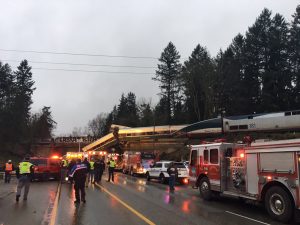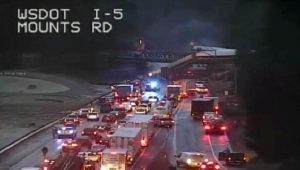
(Reuters) – An Amtrak passenger train derailed on Monday during its inaugural run along a faster route through Washington state, sending part of the train crashing down onto a major highway and killing an unknown number of passengers, authorities said.
The derailment caused “multiple fatalities,” Ed Troyer, a spokesman for the local sheriff’s office, told reporters at the scene, though he did not offer a specific number. The train struck several cars on the highway, he added, causing injuries but no additional deaths.
Seventy-seven people were transported to hospitals in Pierce and Thurston counties, the Tacoma-based CHI Franciscan Health healthcare network said in a statement. Four of them were considered “level red” patients with the most severe injuries.
Approximately 78 passengers and five crew members were aboard the train, Amtrak said in a statement.
People escaped the derailed train by kicking out windows, passenger Chris Karnes told local news outlet KIRO 7.
“All of a sudden, we felt this rocking and creaking noise, and it felt like we were heading down a hill,” Karnes said. “The next thing we know, we’re being slammed into the front of our seats, windows are breaking, we stop, and there’s water gushing out of the train. People were screaming.”

First responders are seen at the scene of an Amtrak passenger train derailment on interstate highway (I-5) in this Washington State Patrol image moved on social media in DuPont, Washington, U.S., December 18, 2017. Courtesy Brooke Bova/Washington State Patrol/Handout via REUTERS
The derailment occurred on the first day Amtrak trains began using a new inland route between the cities of Tacoma and Olympia, part of a project to reduce travel time, according to an October news release from the state’s transportation department.
The rerouting takes trains along Interstate 5, eliminating a major choke point for passenger trains in Tacoma and allowing trains to reach speeds of 79 miles per hour (127 km per hour), the department has said.
Monday’s train, which had been scheduled to depart Seattle at 6 a.m. (1400 GMT) for Portland, Oregon, was the first to run along the new route, which uses tracks owned by a local commuter line.
It was not immediately clear whether the derailment, which came during a busy travel time one week before the Christmas holiday, was connected to the rerouting.
The train derailed around 7:30 a.m. (1530 GMT) in DuPont. A photograph posted by a Washington State Police spokeswoman showed an upside-down train car partially crushed on the highway, with a second car dangling off the overpass.
Authorities warned drivers to avoid the area, and southbound lanes remained closed.
The National Transportation Safety Board was sending a team of investigators to the site, the federal agency said on Twitter.
“Thank you to the first responders on the scene,” Washington Governor Jay Inslee wrote in a Twitter message. “We’re praying for everyone on board the train, and ask everyone to hold them in your thoughts.”

An Amtrak passenger train is seen derailed on a bridge over interstate highway I-5. Courtesy WSDOT/via REUTERS
The mayor of one of the towns through which the rerouted trains travel warned earlier this month that the high-speed trains were dangerously close to cars and pedestrians.
“Come back when there is that accident, and try to justify not putting in those safety enhancements, or you can go back now and advocate for the money to do it, because this project was never needed and endangers our citizens,” Lakewood Mayor Don Anderson told transportation officials in early December, according to Seattle’s KOMO News.
(Reporting by Jonathan Allen and Gina Cherelus in New York; Writing by Joseph Ax; Editing by Chizu Nomiyama and Jonathan Oatis)









